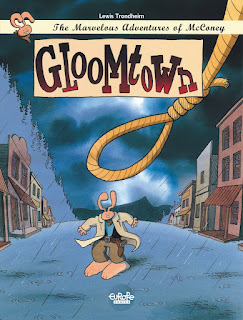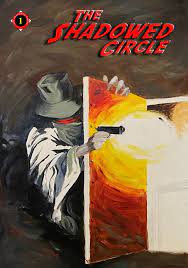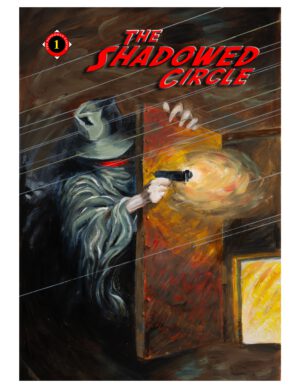Gloomtown by Lewis Trondheim
Lewis Trondheim has done a lot of comics, in lots of different styles and modes. The ones that come closest to major US comics genres – funny books for kids, dark fantasy adventure , autobio stories – have been the most likely to be published well on my side of the Atlantic and to succeed here. The rest…well, publishers keep trying, but some things haven’t really clicked yet.
His first big popular series in his native France, nearly thirty ago now, was Les formidables aventures de Lapinot, a loose series of ten books which all had the same “characters” (anthropomorphic animals, in roughly the same roles in the story and with roughly the same personalities) in which those “characters” often played different roles, as if they were actors cast in movies with each other a lot or the members of a repertory theater company.
Some time ago, Fantagraphics published two of the books in that series – Harum Scarum and The Hoodoodad – in paperbacks matching the size of the original French albums. Both were part of the contemporary “plotline” (as I recall, they didn’t really connect with each other), and I read and enjoyed them quite a while after it was clear Fanta wasn’t going to make what they called “The Spiffy Adventures of McConey” happen.
Well, time marches on, and publishers are enthusiastic about books for a living, so Europe Comics (a newer publisher of graphic novels) jumped in and published three McConey books in digital formats in 2018: Slalom, and Gloomtown, and The Hoodoodad (again). They have slightly modified the series title – Lapinot/McConey is now having “marvelous” rather than “spiffy” adventures, perhaps because it is no longer the late ’90s – and seem to be be planning to do the whole series in initial-publication order, if everything goes to plan.
(Note: there’s been no sign of the remaining seven books in the three years since this first batch, so my guess is that the plan is just as busted as last time. Maybe the next attempt will start from the other end, and translate some different books.)
Gloomtown was published in French as Blacktown, which title gives different expectations in English these days than I gather it did in French in 1995. It’s a Western; McConey (who I don’t think ever gets a name in this book; he’s just “the stranger”) is an Easterner, on the run from a vicious gang for reasons we don’t know as the book opens. He lands in a small town, expecting to spend the night and get out quickly the next morning.
But the town is corrupt and the requisite Old Prospector type has just wandered into town with a big bag of gold, so McConey gets caught up in a battle to find and control the vein of gold somewhere nearby, plus being assumed to be a criminal just because he’s a stranger, plus the subsequent arrival of the very angry ex-Rex Logan Gang. (Logan being ex is the main reason for their anger, at least towards McConey.)
This is an album, so it all has to happen and hit a moderately happy ending in 48 pages, and it does — luckily, being an album, they’re large pages, so Trondheim has room for a lot of dialogue and action and takes advantage of that space. Complications pile on complications, characters race around town and outskirts at high speed, often pursued by each other or by bullets, and more than one character meets a sudden unexpected death.
The tone is similar to Dungeon: not 100% serious, but mostly straight. Trondheim likes to use genre tropes while winking a bit about them at the reader, as if to explain that he likes them, and is happy to exploit them, but doesn’t believe in them.
So I still think the McConey books are fun, and will read as many of them as I can get my hands on. But I do see why they’ve been a harder sell in the USA: Americans, as a class, are allergic to irony, and there’s no throughline of a larger McConey story to keep a reader coming back for the next one.
![]()
![]()
Reposted from The Antick Musings of G.B.H. Hornswoggler, Gent.




















































